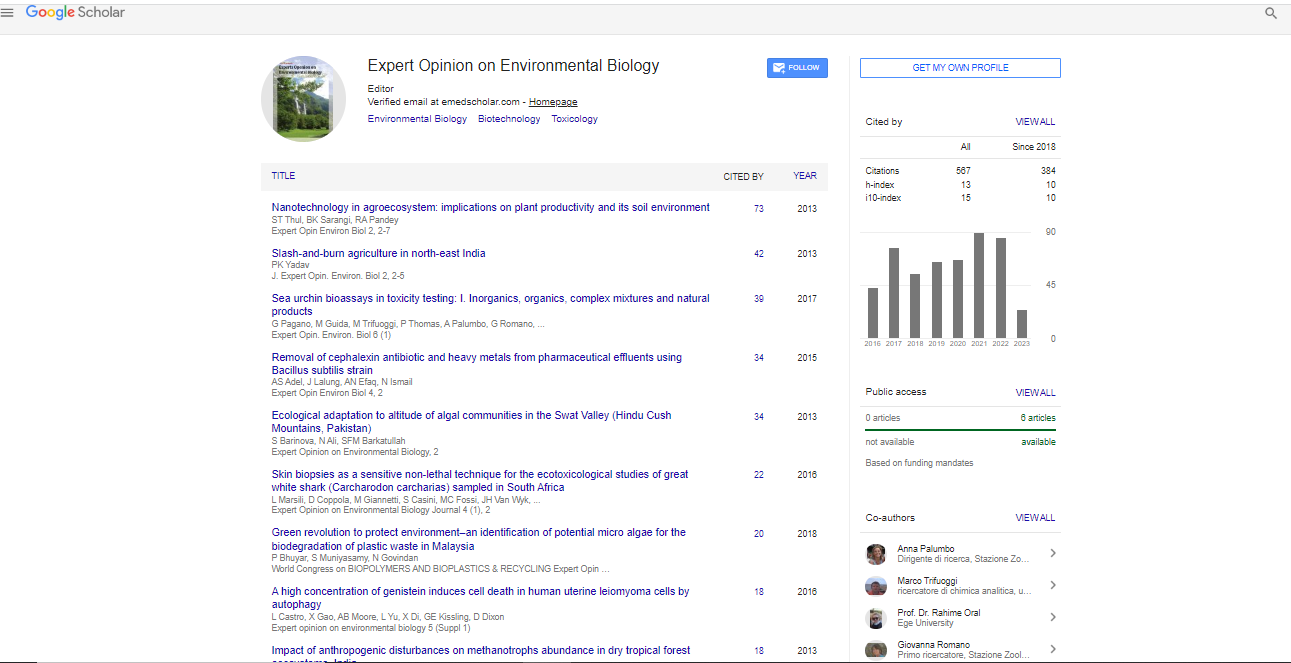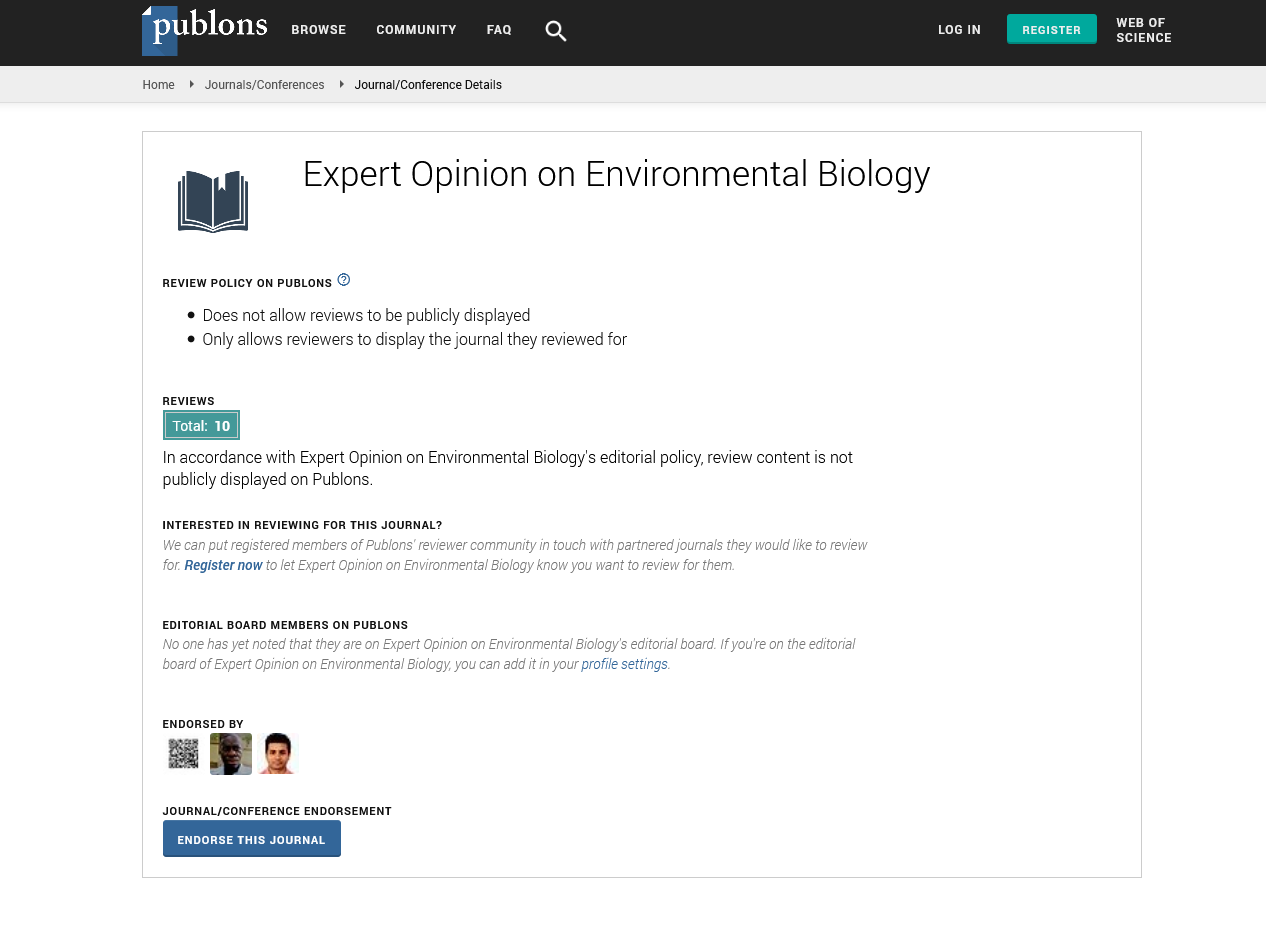Short Communication, Expert Opin Environ Biol Vol: 14 Issue: 1
Climate Change and Its Impact on Global Biodiversity
Laura Vega*
Department of Chemistry and Environmental Science, University of Alicante, Spain
- *Corresponding Author:
- Laura Vega
Department of Chemistry and Environmental Science, University of Alicante, Spain
E-mail: laura_vegaces@11.es
Received: 01-Mar-2025, Manuscript No. EOEB-25-169977, Editor assigned: 03-Mar-2025, PreQC No. EOEB-25-169977(PQ), Reviewed: 17-Mar-2025, QC No. EOEB-25-169977, Revised: 21-Mar-2025, Manuscript No. EOEB-25-169977(R), Published: 28-Mar-2025, DOI: 10.4172/ 2325-9655.1000238
Citation: Laura V (2025) Advancing Cardiac Healing: The Role of Stem Cells in Regeneration and Future Prospects. J Regen Med 14:1.
Copyright: © Laura V (2025) Advancing Cardiac Healing: The Role of Stem Cells in Regeneration and Future Prospects. J Regen Med 14:1.
Abstract
Climate change poses a significant threat to global biodiversity
by altering habitats, shifting species distributions, and disrupting
ecological processes. Rising temperatures, changes in precipitation
patterns, and increased frequency of extreme weather events
are leading to habitat degradation, loss of species, and reduced
ecosystem resilience. This article examines the direct and indirect
effects of climate change on terrestrial, freshwater, and marine
ecosystems. Special attention is given to the vulnerability of endemic
and migratory species, coral reef degradation, and the implications
for human livelihoods dependent on biodiversity. Strategies for
mitigation, such as conservation planning, habitat restoration, and
assisted migration, are discussed to safeguard biodiversity for
future generations.
Keywords: Climate change; Biodiversity loss; Habitat degradation; Ecosystem resilience; Conservation
Keywords
Climate change; Biodiversity loss; Habitat degradation; Ecosystem resilience; Conservation
Introduction
Biodiversity underpins ecosystem services essential for human well-being, including food security, water purification, and climate regulation. However, climate change has emerged as a dominant driver of biodiversity decline, compounding pressures from habitat destruction, pollution, and overexploitation. Understanding these dynamics is critical for developing adaptive management strategies that can preserve ecological integrity [1].
Description
Climate change impacts biodiversity through multiple pathways. Temperature increases shift species' geographic ranges, often forcing them toward higher altitudes or latitudes. Altered precipitation patterns affect plant phenology, water availability, and primary productivity, disrupting species interactions. Extreme weather events, such as droughts, floods, and hurricanes, can cause sudden habitat loss and mortality in sensitive populations. Marine ecosystems face particular challenges, with ocean warming, acidification, and deoxygenation threatening coral reefs, fisheries, and marine food webs. Coral bleaching events have increased in frequency, leading to declines in reef biodiversity and the loss of habitat for countless marine organisms. Freshwater systems are also vulnerable, with altered flow regimes and temperature changes affecting fish spawning cycles and wetland health. Species with narrow ecological niches, low dispersal ability, or specialized diets are at heightened risk. Migratory species face disrupted migration cues and loss of critical stopover habitats. These changes not only affect ecological networks but also jeopardize the livelihoods of communities dependent on natural resources [2], [3].
Results
Scientific assessments, such as the Intergovernmental Science-Policy Platform on Biodiversity and Ecosystem Services (IPBES) reports, indicate that approximately one million species are at risk of extinction within decades if current trends continue. Empirical data show range contractions in tropical amphibians, reduced breeding success in seabirds, and mass mortality events in marine mammals due to changing prey availability. Restoration and conservation efforts have shown potential in buffering these impacts. Protected areas that incorporate climate projections have demonstrated greater species persistence. Assisted migration and ex-situ conservation strategies have been successful for certain high-risk plant species [4], [5].
Discussion
The interplay between climate change and biodiversity loss creates a feedback loop: degraded ecosystems have reduced capacity to sequester carbon, further exacerbating climate change. Effective adaptation requires integrating biodiversity conservation into climate policies, promoting nature-based solutions such as reforestation, wetland restoration, and sustainable agriculture. International cooperation is vital, as many species and ecosystems cross political boundaries. Financial and technical support for conservation initiatives in developing countries, where biodiversity is richest yet most vulnerable, remains a global priority. Public engagement and education can foster behavioral changes that reduce carbon footprints and enhance biodiversity stewardship.
Conclusion
Climate change represents a profound challenge to biodiversity worldwide. Without immediate and sustained action, the loss of species and ecosystem services will accelerate, with severe consequences for both nature and humanity. Strategic, science-based conservation interventions, combined with global climate mitigation efforts, are essential to safeguard biodiversity in an era of rapid environmental change.
References
- DeLong ER, DeLong DM, Clarke-Pearson DL (1988) Comparing the areas under two or more correlated receiver operating characteristic curves: a nonparametric approach. Biometrics 44: 837â??845.
- (2020) MedCalc Software.
- Hogan D, Lan LTT, Diep DTN, Gallegos D, Collins PF (2017) Nutritional status of Vietnamese outpatients with chronic obstructive pulmonary disease. J Hum Nutr Diet 30: 83â??89.
- Collins PF, Elia M, Kurukulaaratchy RJ, Stratton RJ (2018) The influence of deprivation on malnutrition risk in outpatients with chronic obstructive pulmonary disease (COPD). Clin Nutr 37: 144â??148.
- Pinzón-Espitia O, Pardo-Oviedo J, Ibáñez-Pinilla M (2021) Detection of nutritional risk and hospital stay in the hospitalized elderly adult. Nutr Hosp 38: 464â??469.
 Spanish
Spanish  Chinese
Chinese  Russian
Russian  German
German  French
French  Japanese
Japanese  Portuguese
Portuguese  Hindi
Hindi 
